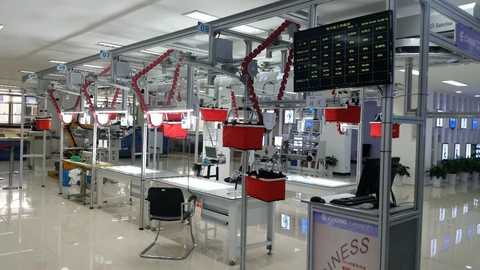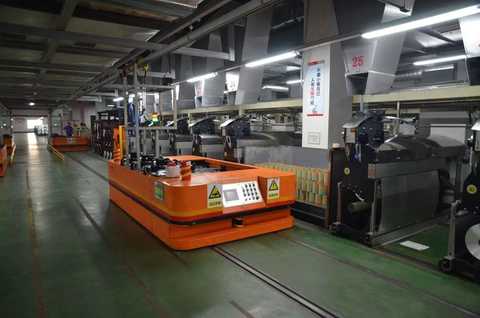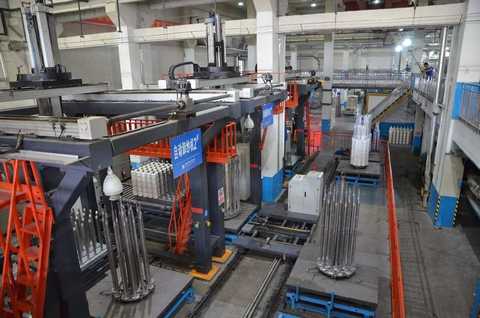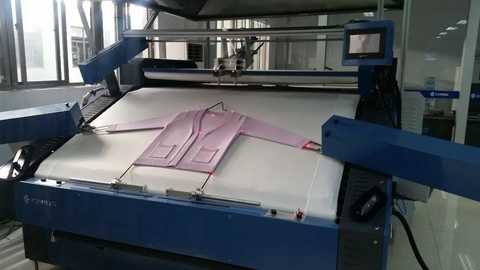Development Status of Five Years of Rapid Transformation and Upgrading in the Information Age of Textile Industry
In the five years since the 18th National Congress of the Communist Party of China, in the context of the rapid development of the new generation of information technology and the global technological innovation, the informationization of the textile industry has been urgently in demand for informationization due to the transformation and upgrading of the textile industry. The guidance and support of major policies have achieved faster development than ever before. The integration of the two technologies has gone deeper, breakthroughs have been made in key technologies, and the traditional industries of information technology transformation have been accelerated. Smart manufacturing has set up pilot demonstrations. The application of the Internet has gradually deepened, new modes and new formats have continued to grow, and the level of informationization in the industry has significantly improved. It has become an important driving force to lead the industry in innovation, drive transformation and upgrading, and achieve the goal of strengthening the country.
The central government introduced a strategic deployment of two-in-one deep integration

In November 2012, the party’s 18th National Congress report pointed out: “Insist on the road of new industrialization, informationization, urbanization and agricultural modernization with Chinese characteristics, promote the deep integration of informationization and industrialization, benign interaction of industrialization and urbanization, urbanization and agriculture. Modernization and coordination, promoting the simultaneous development of industrialization, informationization, urbanization, and agricultural modernization have pointed out the direction for the new industrialization road with Chinese characteristics. In the following five years, it was the most intensive period to support the policy of supporting the integration of the two.
In May 2015, the State Council issued "Made in China 2025", which is the action plan of the Chinese government to implement the first decade of the strategy of manufacturing a strong country, highlighting the main line of deep integration of the two. The document pointed out that it is necessary to accelerate the integration of the new generation of information technology and manufacturing industry as the main line, and clarify the important position of the integration of the two industries in the transformation and upgrading of the entire manufacturing industry, and it is also a commanding height for China's manufacturing industry.
In July 2016, the Central Office and the State Council issued the Outline of the National Informatization Development Strategy (referred to as the “Strategic Outlineâ€). Based on the process of information construction in China and the new situation, the new guiding ideology, strategic goals and basics were clarified. The guidelines and major tasks have made clear plans for the future development of informatization from three aspects: enhancing information development capability, improving information application level, and optimizing information development environment. Among them, the relevant content of “improving the level of informatization application†is the closest to textile informatization.
Subsequently, various government departments issued a series of documents such as “Guiding Opinions on Actively Promoting “Internet+†Actions, “Intelligent Manufacturing Development Planâ€, and “Guiding Opinions on Deepening the Integration of Manufacturing and Internetâ€. In terms of the integration of the two-in-depth integration, it also provides strategic guidance for textile information construction.
Significant progress in transforming traditional industries with information technology

Product design information is widely promoted. Technologies such as CAD have matured and have become the norm in textile applications. In the past five years, under the technical support of 3D anthropometry, clothing human body database, virtual fitting, etc., the clothing design based on the Internet environment and personalized customization has been gradually promoted; the interface technology of CAD and CAM and related standards have made progress; textile color and The digital management of related processes is further in-depth; the combination of fabric pattern design and clothing style design has been tried; PLM has been applied and played a role in comprehensive integration.
There are already a variety of related software products in China, which have a large market share, and some have reached the international advanced level, and the price is far lower than that of similar foreign products, and it is competitive in the international market.
Production and management progress is most evident. Due to the accelerated pace of equipment renewal and technological transformation in textile enterprises in recent years, the MES promotion based on the Internet of Things has been rapid, and the online monitoring system has established typical applications, and a large number of technology and service providers have emerged.
The printing and dyeing production process monitoring system has been promoted the fastest in recent years, and there are many solutions for users to choose, such as Hangzhou Open Source, Changzhou Hongda, Xi'an Degao, Foshan Nanhai Tianfu, etc., to stabilize product quality, improve production efficiency and optimize for printing and dyeing enterprises. Production technology and promotion of energy conservation and emission reduction have played an important role; the integration level of cotton spinning online monitoring and management system has been significantly improved, and the adaptability has been enhanced. Generally, it is not limited to specific suppliers, and can be connected to various types of equipment, and can also be connected with ERP. The systems developed by Jingwei New Technology, Xiamen Softcom, Changling Spinning Power, etc. have typical applications; the garment production management system uses RFID technology to realize production task schedule control, production material tracking, production quality monitoring, and real-time monitoring and scheduling of production core links. Such functions, Tianze Yingfeng first provided these technologies; Internet-based knitting network management systems, such as Fujian Ruineng, Jiangnan University Knitting Center and other units developed systems with production performance analysis, production quality traceability and production intelligent scheduling . More and more suppliers have launched a total solution for the integration of MES and ERP, and the application level and technical level have significantly improved.
Enterprise information management has begun to enter a new stage. The application of management software such as ERP is continuously promoted, functions are improved day by day, and a series of new application modes are adopted, which are more integrated with application systems such as PDM and MES. CRM and SCM play a better role in the Internet environment. Management informationization begins to enter a new phase of integrated applications.
The ERP construction of Bosideng, Shannanshan, Anhui Huamao and other leading enterprises has been continuously improved and deepened, and closely combined with the production and operation of enterprises, the overall management information level has been significantly improved; Wuxi Yimian, Shandong Lutai, Jiangsu Yueda and other enterprises as The pilot demonstration of the cotton textile industry has deepened the application of ERP in recent years, and gradually built a power monitoring system, a quality monitoring system, an online monitoring system for equipment, etc., which played a significant role in supporting the transformation of production and business models; Shandong Ruyi Group and Xi'an University of Science and Technology cooperated in the development and application of a collaborative production management system for the textile and garment manufacturing process, focusing on solving the optimization problems in the production planning process, which is conducive to the synergy of upstream and downstream enterprises in the textile and garment industry chain; Hunan can't forget the company's development including clothing design. The informatization integrated management system of the process database and production management covers the clothing design, production and operation of the enterprise.
Intelligent manufacturing has become the main direction

Intelligent manufacturing has become a new focus area of ​​industry informationization. After the publication of "Made in China 2025", smart manufacturing has become a breakthrough and key area for the transformation and upgrading of the manufacturing industry. Governments at all levels have also taken it as a strong manufacturing force and have given various forms of special support. The Ministry of Industry and Information Technology and the Ministry of Finance issued the "Intelligent Manufacturing Development Plan (2016~2020)", which clarified the guiding ideology, goals and ten key tasks of China's smart manufacturing development during the "13th Five-Year Plan" period, and set up smart manufacturing every year from 2015. Comprehensive standardization and new model application specialties, selected intelligent manufacturing pilot demonstration enterprises, Shandong Kang Pinna, Qingdao Red Collar, Ningbo Cixing, Jiangsu Dasheng and other dozens of textile enterprises have been selected.
The intelligent production line has established a pilot demonstration of the industry. The intelligentization of the production process represented by intelligent production lines is the core of intelligent manufacturing, with the largest investment and the most attention.
Shandong Kangpinna Company has developed a complete set of digital automatic dyeing technology and equipment, developed a central automatic control system for the whole process of dyeing production, created a digital automatic and efficient dyeing production line for cheese, and established a digital dyeing workshop. The production process can be seamless. The connection realizes the unmanned operation of the dyeing site. The project won the first prize of National Science and Technology Progress Award in 2014 and was applied to many enterprises such as Shandong Lutai.
The cotton spinning industry has built pilots for spinning production lines such as Shandong Huaxing and Jiangsu Dasheng, which are very influential in the industry. For example, Shandong Huaxing's ring spinning intelligent production line, including online monitoring information system, canal AGV conveying system, fine yarn joint intelligent navigation system, yarn intelligent packaging and conveying system, etc., has realized the equipment and systems of different suppliers at home and abroad. The process is integrated and integrated, and a continuous and automated production line from raw material input to finished product storage is built.
The intelligent logistics system made a breakthrough. In the past five years, the production logistics system of chemical fiber and cotton spinning enterprises has formed a breakthrough in technology, and the application has achieved rapid development. It has become an important part of the production line and a link connecting various links, which has improved the automation of the production line.
The automatic drop system developed by Beizi has realized the automation of wire drop, loading and transfer, and can automatically complete the tracking and label printing of the cake product information. Together with the automatic packaging logistics system, it can realize the silk cake falling. Full automation of the barrel, transport, storage, inspection and classification, and packaging to palletizing. After many chemical fiber companies such as Shenghong Group put into operation, they have greatly reduced their labor and increased their daily packaging output.
Qingdao Saite Global's automatic packaging and packaging logistics system, including automatic identification and conveying of bobbins, stacking, demolition, visual inspection, weighing and screening, multi-mode automatic packaging, automatic packing, and whole package (box) Relabeling, packaging, palletizing, inbound and outbound functions. It can automatically identify and track the yarn variety, and adopt the whole process quality monitoring of visual recognition technology to automatically reject the unqualified yarn. It has been applied to Weiqiao Textile and other enterprises, which has greatly improved the automation level of the downstream process of the spinning production line.
Customized service new model continues to innovate

With the rapid development of e-commerce, the personalized customization model has been favored by more and more enterprises, and gradually moved to practical applications. Customized services, as an important innovation model for manufacturing service transformation, have huge room for development.
As the pioneer enterprise of personalized customization, Qingdao Red Collar has been applied to the personalization of men's suits for many years, and has made new progress in the past five years. According to the large-scale model library, with the order information flow as the core, the task is distributed to the distributed manufacturing system composed of multiple flexible processing units controlled by the computer network, which realizes rapid response, while in the background, there is a strong informationization. System support.
Ningbo Cixing has developed a custom knitting sweater system that provides ready-to-use, on-demand sweater styles, plate making software, weaving process sheets and equipment modifications. Through the integration of upstream and downstream resources, the formation of a network including product design, order acceptance, process plate making, raw material warehouse, weaving production, semi-finished warehouse, sewing production, decontamination soft, ironing stereotypes, quality inspection, finished product warehouse, logistics and distribution Chemical industry chain.
Guangdong Astar Apparel Co., Ltd. has integrated online shopping marketing with manufacturing, and developed a “smart tailor†network platform for T-shirts, jeans and other clothing. The consumer inputs the relevant data through the keyboard, and the virtual fitting system on the Internet has a screen display; the platform also provides a large number of fabrics, colors, patterns, styles, etc., and the consumer selects according to preferences; after final confirmation, the order is placed and submitted to the workshop for production.
The industry application of Internet technology is deepening

In the past five years, the new generation of information technology has developed rapidly and the Internet has become more and more popular. Under the impetus of national policies, "Internet +" has become a prominent force and has become the focus of the industry and the society as a whole. The textile industry has deepened Internet applications and brought profound changes to the traditional industry model.
The e-commerce platform has developed rapidly, especially the development of B2C platforms for consumers such as Taobao and Jingdong is beyond expectations. In 2016, the total amount of textile and apparel e-commerce transactions was 4.45 trillion yuan, 2.4 times that of 2012. The development of e-commerce drives the Internet to extend upstream and downstream of the supply chain. For example, based on the e-commerce business of end products such as Hongdou Mall, Jiangsu Red Bean has built up the relationship between the Red Bean Group and the upstream and downstream supply chain based on the advantages of the Red Bean Telecom and Textile Materials Trading Center. The raw material e-commerce platform.
The service platform for the information service platform for small and medium-sized enterprises has increased. For example, the service platforms of industrial clusters such as Zhejiang Shaoxing and Guangzhou East and West are supported by new technologies and operation models such as cloud computing, and the business is developing rapidly; the industrialized software is promoted through the cloud platform. , formed some "textile clouds", such as Wuhan Textile University, to provide resources for the majority of textile enterprises to optimize the sharing, the use of safe and reliable services.
Software developers have launched SaaS software rental services in the textile industry, ready to use, on-demand, pay-per-use, such as clothing ejection service launched by Hangzhou Aike; equipment manufacturers to track the operating data of global customers in real time, to the factory equipment Provide remote diagnosis and post-maintenance, such as Fujian Rui Neng's knit flat knitting machine network monitoring platform.
Mobile internet technology is booming and has been widely used in office automation (OA) and e-commerce for textile companies. The mobile application expands the application scenario of ERP and realizes innovative applications that are difficult to implement by traditional management software with the help of mobile features.
The big data application has started, and it has been used for precision marketing and demand positioning of textiles and garments. The industry-level big data information service platform is also under construction. At the enterprise level, a large amount of data is accumulated in the ERP system, and huge resources are formed with data from other sources such as the Internet of Things and social networks, which is of great significance to the business decision-making and forecasting of the enterprise.
Editor in charge: Xu Yuehua
Plain Teddy Fleece,Solid Teddy Wool,Two Sides Teddy Fleece,Polyester Teddy Fleece
Jiangyin Xiangxu Textile Co., Ltd. , https://www.xiangxutextile.com